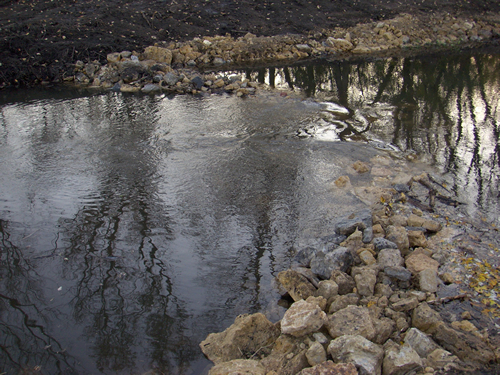Wing Deflectors
What is it?
Wing deflectors are rock structures built out from either or both streambanks (single wing deflectors and double wing deflectors) towards the center of the stream. Double wing deflectors can be used to correct over-widened streams and direct stream velocities away from eroding banks. Single wing deflectors can be used to restore channel morphology, stream sinuosity, and create instream habtiat like undercut banks.
 (
photo from the Upper Rock River Partnership. Link to Wing Deflector example.)
(
photo from the Upper Rock River Partnership. Link to Wing Deflector example.)
Conservation Benefits
- Provides instream habitat for fish and other aquatic organisms
- Reduces stream bank erosion and instream scouring
What does it include?
Wing deflectors are rock structures that will very in size and location depending on the stream size, baseflow, streambank erosional issues, and instream habtiat needs. Technical experts should be consulted to determine proper size and placement of structures to prevent unintented changes in stream morphology and streambank erosion.
Wing Deflector Links
- Deflectors (p 7; TCEQ)
- Deflectors (Ohio Department of Natural Resources)
- Double wing deflectors (NRCS)
- Low deflectors (p 278; Cooperative Research Centre for Catchment Hydrology)
- Wing deflectors (p 125; Center for Watershed Protection)
Wing Deflectors Bibliography
- Gerhard and Reich. 2000. Restoration of streams with large wood: effects of accumulated and built-in wood on channel morphology, habitat diversity, and aquatic fauna. International Review of Hydrobiology 85: 123-137.
- Laasonen et al. 1998. Recovery of macroinvertebrate communities from stream habitat restoration. Aquatic Conservation: Marine and Freshwater Ecosystems 8: 101-113.
- Muotka et al. 2002. Long-term recovery of stream habitat structure and benthic invertebrate communities from in-stream restoration. Biological Conservation 105: 243-253.
- Roni et al. 2002. A review of stream restoration techniques and a hierarchical strategy for prioritizing restoration in Pacific Northwestern watersheds. North American Journal of Fisheries Management 22: 1-20.